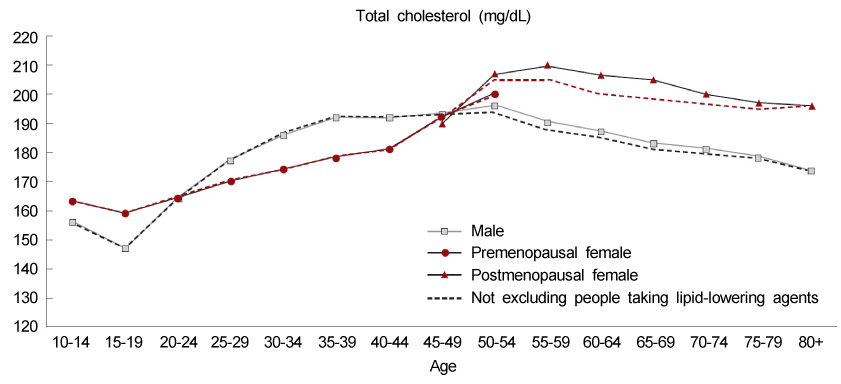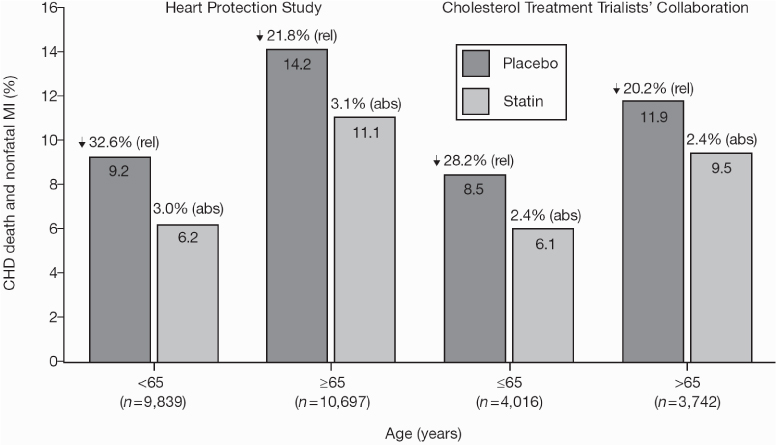J Lipid Atheroscler.
2015 Jun;4(1):1-6. 10.12997/jla.2015.4.1.1.
Dyslipidemia in Older Adults and Management of Dyslipidemia in Older Patients
- Affiliations
-
- 1Department of Internal Medicine, Seoul National University Bundang Hospital, Seongnam, Korea. kikim907@snu.ac.kr
- KMID: 2005729
- DOI: http://doi.org/10.12997/jla.2015.4.1.1
Abstract
- In Korea, the number of older adults, particularly of the very elderly people, is expected to be increasing for the upcoming years. This demographic change has profound implication for medical and health care systems. As more people live a longer life, it is important to understand the chronic diseases or health problems which affect the health status or quality of life among the older adults. It has been well established that cardio-cerebrovascular diseases have important roles and impacts on functional capacity and health status of older adults. Recently, many risk factors which increase the risk of cardio-cerebrovascular diseases have been identified. Among them, dyslipidemia is one of the most important risk factor for cardio-cerebrovascular disease. However, there remain several questions regarding the clinical importance of dyslipidemia in older adults, safety and efficacy issue in treating dyslipidemia with statin in older adults, and the relationship between genetic factors associated with lipid profile and longevity. In this review, I will discuss current evidence and data on the topic of dyslipidemia in older adults.
Keyword
MeSH Terms
Figure
Cited by 1 articles
-
Epidemiology of dyslipidemia in Korea
Hyeon Chang Kim
J Korean Med Assoc. 2016;59(5):352-357. doi: 10.5124/jkma.2016.59.5.352.
Reference
-
1. Statistics Korea. Population projections per Korea: 2010-2060. Daejeon: Statistics Korea;2011.2. Kannel WB, Vokonas PS. Demographics of the prevalence, incidence, and management of coronary heart disease in the elderly and in women. Ann Epidemiol. 1992; 2:5–14.
Article3. Park JH, Lee MH, Shim JS, Choi DP, Song BM, Lee SW, et al. Effects of age, sex, and menopausal status on blood cholesterol profile in the korean population. Korean Circ J. 2015; 45:141–148.
Article4. Schatz IJ, Masaki K, Yano K, Chen R, Rodriguez BL, Curb JD. Cholesterol and all-cause mortality in elderly people from the Honolulu Heart Program: a cohort study. Lancet. 2001; 358:351–355.
Article5. Ferrara A, Barrett-Connor E, Shan J. Total, LDL, and HDL cholesterol decrease with age in older men and women. The Rancho Bernardo Study 1984-1994. Circulation. 1997; 96:37–43.
Article6. Raffel OC, White HD. Drug insight: statin use in the elderly. Nat Clin Pract Cardiovasc Med. 2006; 3:318–328.
Article7. Arai Y, Hirose N. Aging and HDL metabolism in elderly people more than 100 years old. J Atheroscler Thromb. 2004; 11:246–252.
Article8. Walter M. Interrelationships among HDL metabolism, aging, and atherosclerosis. Arterioscler Thromb Vasc Biol. 2009; 29:1244–1250.
Article9. Shepherd J, Blauw GJ, Murphy MB, Bollen EL, Buckley BM, Cobbe SM, et al. Pravastatin in elderly individuals at risk of vascular disease (PROSPER): a randomised controlled trial. Lancet. 2002; 360:1623–1630.
Article10. Glynn RJ, Koenig W, Nordestgaard BG, Shepherd J, Ridker PM. Rosuvastatin for primary prevention in older persons with elevated C-reactive protein and low to average low-density lipoprotein cholesterol levels: exploratory analysis of a randomized trial. Ann Intern Med. 2010; 152:488–496. W174.
Article11. Pencina MJ, Navar-Boggan AM, D'Agostino RB Sr, Williams K, Neely B, Sniderman AD, et al. Application of new cholesterol guidelines to a population-based sample. N Engl J Med. 2014; 370:1422–1431.
Article12. Wenger NK, Lewis SJ, Herrington DM, Bittner V, Welty FK. Treating to New Targets Study Steering Committee and Investigators. Outcomes of using high- or low-dose atorvastatin in patients 65 years of age or older with stable coronary heart disease. Ann Intern Med. 2007; 147:1–9.
Article13. Neil HA, DeMicco DA, Luo D, Betteridge DJ, Colhoun HM, Durrington PN, et al. Analysis of efficacy and safety in patients aged 65-75 years at randomization: Collaborative Atorvastatin Diabetes Study (CARDS). Diabetes Care. 2006; 29:2378–2384.
Article14. Lewis SJ, Moye LA, Sacks FM, Johnstone DE, Timmis G, Mitchell J, et al. Effect of pravastatin on cardiovascular events in older patients with myocardial infarction and cholesterol levels in the average range. Results of the Cholesterol and Recurrent Events (CARE) trial. Ann Intern Med. 1998; 129:681–689.
Article15. Kjekshus J, Apetrei E, Barrios V, Böhm M, Cleland JG, Cornel JH, et al. Rosuvastatin in older patients with systolic heart failure. N Engl J Med. 2007; 357:2248–2261.
Article16. European Association for Cardiovascular Prevention & Rehabilitation. Reiner Z, Catapano AL, De Backer G, Graham I, Taskinen MR, et al. ESC/EAS Guidelines for the management of dyslipidaemias: the Task Force for the management of dyslipidaemias of the European Society of Cardiology (ESC) and the European Atherosclerosis Society (EAS). Eur Heart J. 2011; 32:1769–1818.17. Lee DS, Markwardt S, Goeres L, Lee CG, Eckstrom E, Williams C, et al. Statins and physical activity in older men: the osteoporotic fractures in men study. JAMA Intern Med. 2014; 174:1263–1270.
- Full Text Links
- Actions
-
Cited
- CITED
-
- Close
- Share
- Similar articles
-
- Association between the Risk of Obstructive Sleep Apnea and Blood Lipid Levels
- Practical Approaches to Managing Dyslipidemia in Patients With Metabolic Dysfunction-Associated Steatotic Liver Disease
- Older Adults with Diabetes in Korea: Latest Clinical and Epidemiologic Trends
- Mechanism, clinical consequences, and management of dyslipidemia in children with nephrotic syndrome
- Management Status of Cardiovascular Disease Risk Factors for Dyslipidemia among Korean Adults



